Fire of 1893
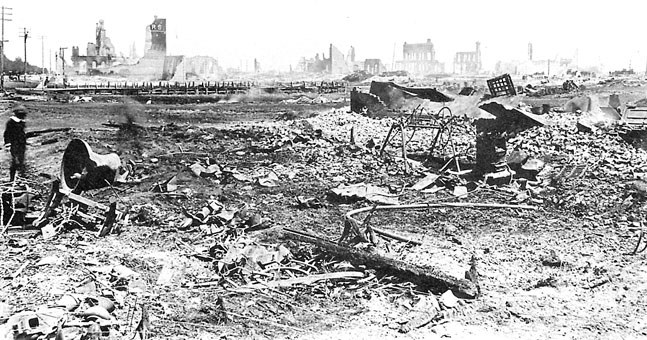
Fargo continued to grow in the 1890's but one event changed it forever. About 3 PM on the afternoon of June 7, 1893, the worst fire in the history of Fargo began in downtown and spread from wood building to wood building, destroying city hall, the business district and the homes of most of Fargo’s 6,000 residents. The Fargo Forum in a special edition the day of the fire, reported that the fire began when someone threw ashes from the rear of the Little Gem Restaurant on Front Street and started a fire in the rear of Herzman's Dry Goods Store at 512 Front Street. Another version of the fire suggested that Lily Herzman was burning cardboard packing cartons behind the store and the flames spread to the building.
Whatever the origin, the fire spread from Front Street (now Main Avenue) to the north. By the end of the day, downtown Fargo was devastated. Over 160 acres were in ashes and over 31 blocks of businesses and residences were destroyed stretching along Broadway from NP Avenue to Fifth Avenue North and west to the prairie. By one count, 140 residences and 219 businesses were destroyed. Most of the buildings before the fire were constructed of wood.
The picture above shows downtown after the fire. The ashes are still smoldering. The photographer is facing northeast from the corner of Roberts Street and NP Avenue. At left center lies the firehouse bell.
After the fire, Fargo city leaders adopted building codes that resulted in most buildings being constructed of brick. The rebuilding of Fargo began immediately.
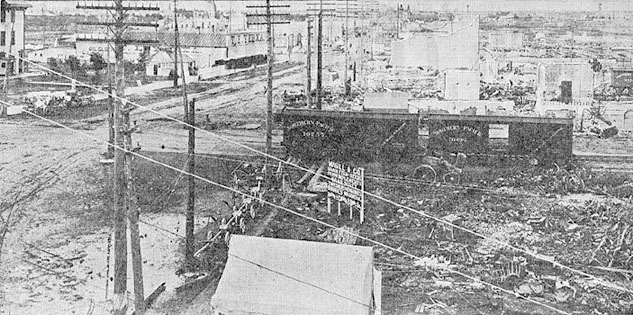
The picture above looks north after the fire from Front Street. On the far left, one can see the corner of the Headquarters Hotel and in the upper left center the T. E. Yerxa department store on the southwest corner of Broadway and NP Avenue. Running from the left edge toward the upper center is Broadway and the NP tracks are obvious from the railroad cars. Nearly everything east of Broadway to the Red River was burned to the ground. Nearly all buildings west of Broadway and north of NP Avenue were also lost.
A number of factors contributed to the devastation. One of Fargo's three fire companies (the one located across the street from the origin of the fire) was out sprinkling streets (a normal fire department duty). The nearest fire alarm box was at the corner of Broadway and Sixth Street (in front of Moody's) and no one could find the key. Both of these events delayed getting water on the fire. The buildings at that time were primarily constructed of wood and the fire spread rapidly with a 30mph wind that day. Fargo's three fire companies fought the fire valiantly but all of the factors mentioned simply proved too much.
The city council met frequently in the coming days to deal with the crisis. They authorized dumping of fire debris in the slough where it crossed Third Avenue south, established a city fire inspector, required stone or concrete sidewalks, prohibited using the fire department for street sprinkling, and similar actions to mitigate further disasters.
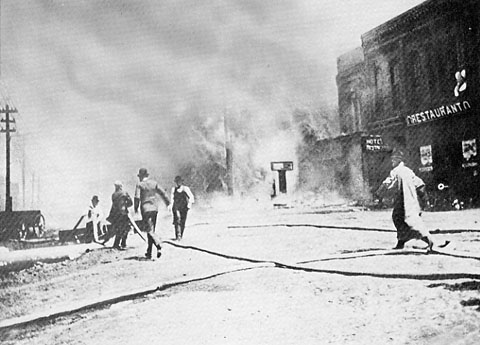
The picture above by Moorhead photographer O. E. Flaten looks southeast on Front Street from Broadway. One can see the approximate location of the start of the fire as smoke billows forth. The fire had not yet spread north across Front Street at this time. One can see Fargo's fire companies pulling hoses to fight the fire.
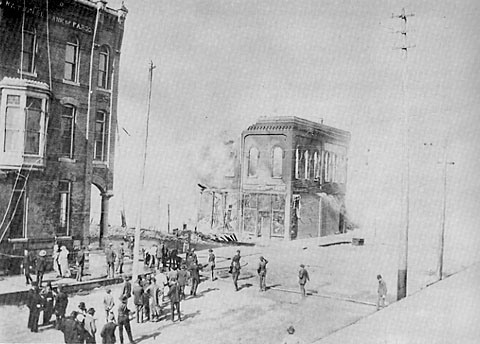
The picture above looks northeast at the corner of Broadway and NP Avenue. The fire was burning on the east side of Broadway but had not yet spread across to the west side at the time this photograph was taken. Fargo city offices were on the upper floors of the building on the left. Nearly all city records were destroyed when the fire consumed the building

The picture above was taken the day after the fire. The photograph looks northwest Front Street (Main Avenue) and Fourth Street. The NP railroad tracks run through the center.

The picture above was taken the day after the fire. I don't know the vantage point but Fargo citizens are standing on one of the few wooden sidewalks not destroyed in the fire.
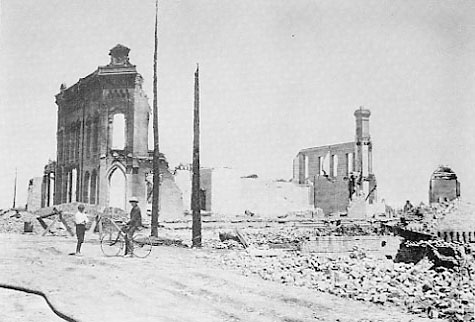
The top picture is a photograph of the Keeney Building at Broadway and Second Avenue after the fire. Note the clock housing atop the the beveled corner of the face of the building. Also note in the left center the distinctive chimney on the facade still standing behind the Keeney building and the angle at which the partially destroyed wall falls away from the corner opposite the chimney.
The same buildings can be seen in the panoramic image of downtown after the fire. Look under the "93" in the "Fire of 1893" title. You will see the Keeney Building and the "chimney building" to the right of it.
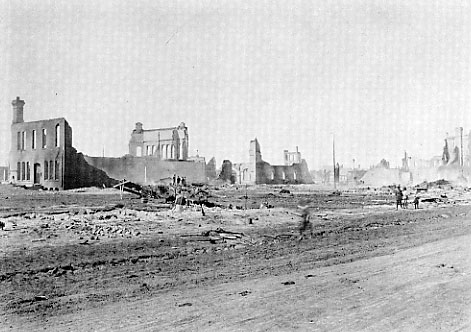
In this photograph, the closest structure that can be seen (on the left) is the same far corner of the "chimney" building noted in the top photograph above. Beyond that facade, one can see (in the center) the inside of that beveled Keeney building front wall seen in the top photograph above. The "clock housing bevel" is the corner furthest away.
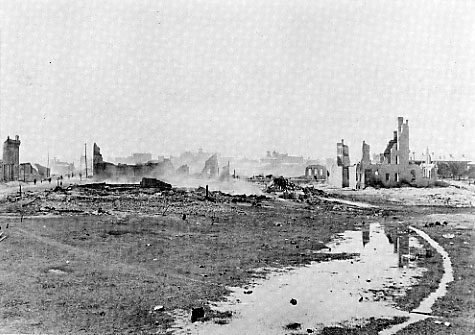
On the far left side of this photograph, you can again see the profile of the Keeney building, with the clock structure on the far side. The jagged tower-like ruins across the street from it (with the broad flat structure extending to the right of it) as well as the chimney of the only four-story building in sight (to the far right) is unmistakable.
I do not know the location of these photographs.

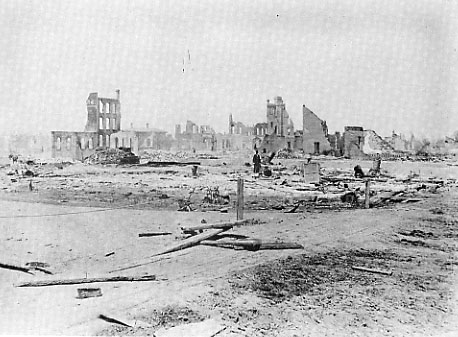
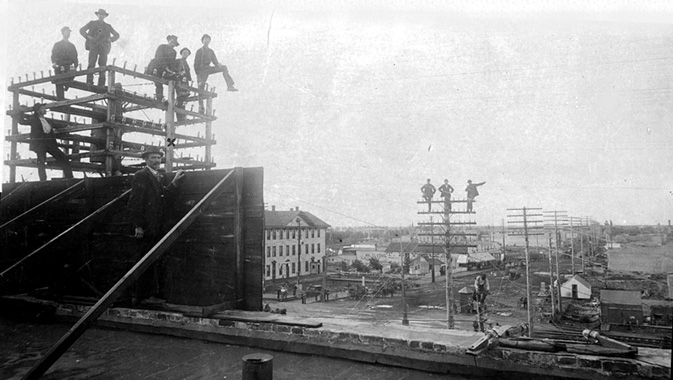 Constructing telephone poles after the Fargo fire
Constructing telephone poles after the Fargo fire
This early photograph looks north on Broadway from the roof of the telephone building which by the picture would have to be in United Block or a building just east of it. The picture appears to commemorate the erection of telephone poles likely destroyed in the Fargo fire of 1893. Just right of the large roof sign, one can see the Headquarters Hotel and the Yerxa store north of it. An enlargement of the business area can be seen below.
 (photo courtesy of Steve Schack)
(photo courtesy of Steve Schack)
